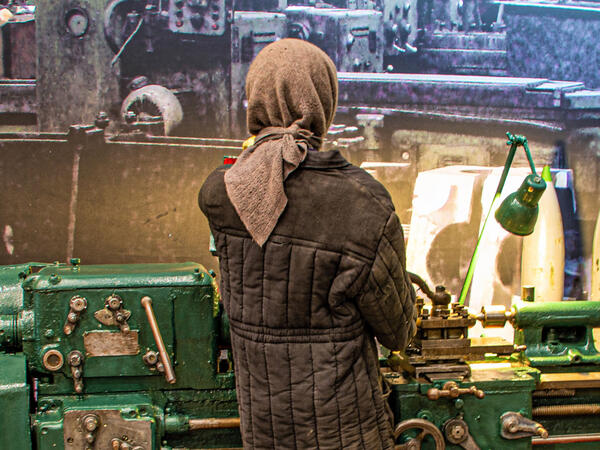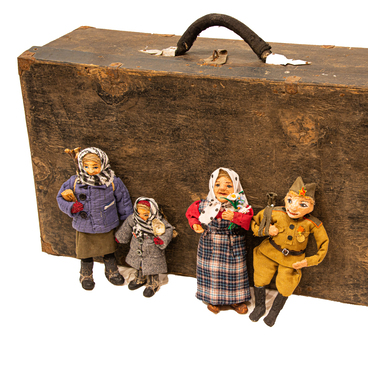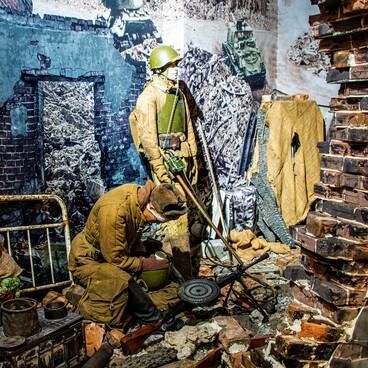On June 22, 1941, at noon, People’s Commissar for Foreign Affairs Vyacheslav Molotov announced over the radio that Nazi Germany had treacherously attacked the USSR. By the Decree of the Presidium of the Supreme Soviet of the USSR, overtime work was legalized, weekends and vacations were canceled and a two-shift 11-hour working day was introduced at all industrial enterprises all over the country, including the Kolomensky Zavod (machine-building plant).
In the very first days of the war, the plant switched to a new work schedule and the strictest savings policy. Many engineers worked for 15 hours straight. On the second or third day of the war, 230 teenagers came to the plant — students in their 9th and 10th grades, and started working on the machines instead of their parents. Often, after the shift, they were too exhausted to go home and slept right next to their workplace.
In 1941, the Kolomensky Zavod produced diesel engines for “Leninets” class submarines and set up production of armored hulls and parts for the T-60 light tanks.
The Kolomensky Zavod workers had to learn new skill sets. In addition to their own workload, they also worked on other machines instead of their comrades who had gone to fight, performed difficult tasks and covered for their friends.
In mid-July 1941, the first trains with wounded Red Army soldiers arrived in Kolomna. Hospitals were established in the Palace of Culture and the House of Knowledge, which belonged to the plant. In addition, the plant workers implemented several blackout measures in the city and dug narrow protective trenches for each workshop: since July 22, enemy aircraft constantly did flybys over Kolomna and the Kolomensky Zavod.
Many workers were engaged in defensive lines building. Metal barriers (anti-tank hedgehogs) and armored turrets (permanent structures for defense and shooting) were cast at the Kolomensky Zavod. For the protection of Moscow, 500 such armored turrets and 2.2 thousand anti-tank hedgehogs were installed on the Kolomna to Lyublino line; its length was 132 kilometers. The barriers were also erected on the city streets. On October 19, 1941, a state of siege was officially proclaimed in Kolomna and it became a front-line city.
In October 1941, most of the plant facilities had to be evacuated to the city of Kirov. Nevertheless, they continued to manufacture platforms for anti-aircraft missiles, rocket launchers, shells, and a host of other things.
The Kolomensky Zavod workers made a significant contribution to the victory over the enemy. In 1942, when there was a lack of specialists and equipment shortages, another armored train (Bronepoezd) was built, it traveled from Tula to Germany. At the same time, the plant executed an order for the Magnitogorsk Iron and Steel Works Factory (it produced equipment for Ural pipe plants). That same year, the production of diesel engines was renewed at the plant and some of the specialists returned from Kirov to Kolomna, where they continued to work during the war.
In the very first days of the war, the plant switched to a new work schedule and the strictest savings policy. Many engineers worked for 15 hours straight. On the second or third day of the war, 230 teenagers came to the plant — students in their 9th and 10th grades, and started working on the machines instead of their parents. Often, after the shift, they were too exhausted to go home and slept right next to their workplace.
In 1941, the Kolomensky Zavod produced diesel engines for “Leninets” class submarines and set up production of armored hulls and parts for the T-60 light tanks.
The Kolomensky Zavod workers had to learn new skill sets. In addition to their own workload, they also worked on other machines instead of their comrades who had gone to fight, performed difficult tasks and covered for their friends.
In mid-July 1941, the first trains with wounded Red Army soldiers arrived in Kolomna. Hospitals were established in the Palace of Culture and the House of Knowledge, which belonged to the plant. In addition, the plant workers implemented several blackout measures in the city and dug narrow protective trenches for each workshop: since July 22, enemy aircraft constantly did flybys over Kolomna and the Kolomensky Zavod.
Many workers were engaged in defensive lines building. Metal barriers (anti-tank hedgehogs) and armored turrets (permanent structures for defense and shooting) were cast at the Kolomensky Zavod. For the protection of Moscow, 500 such armored turrets and 2.2 thousand anti-tank hedgehogs were installed on the Kolomna to Lyublino line; its length was 132 kilometers. The barriers were also erected on the city streets. On October 19, 1941, a state of siege was officially proclaimed in Kolomna and it became a front-line city.
In October 1941, most of the plant facilities had to be evacuated to the city of Kirov. Nevertheless, they continued to manufacture platforms for anti-aircraft missiles, rocket launchers, shells, and a host of other things.
The Kolomensky Zavod workers made a significant contribution to the victory over the enemy. In 1942, when there was a lack of specialists and equipment shortages, another armored train (Bronepoezd) was built, it traveled from Tula to Germany. At the same time, the plant executed an order for the Magnitogorsk Iron and Steel Works Factory (it produced equipment for Ural pipe plants). That same year, the production of diesel engines was renewed at the plant and some of the specialists returned from Kirov to Kolomna, where they continued to work during the war.



